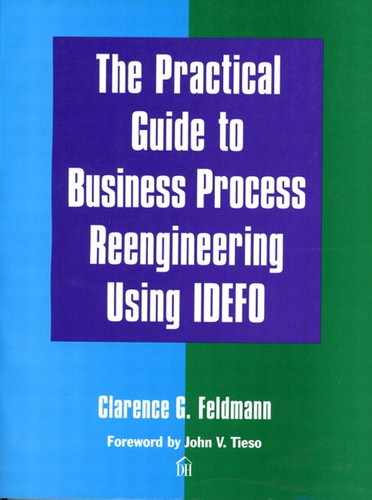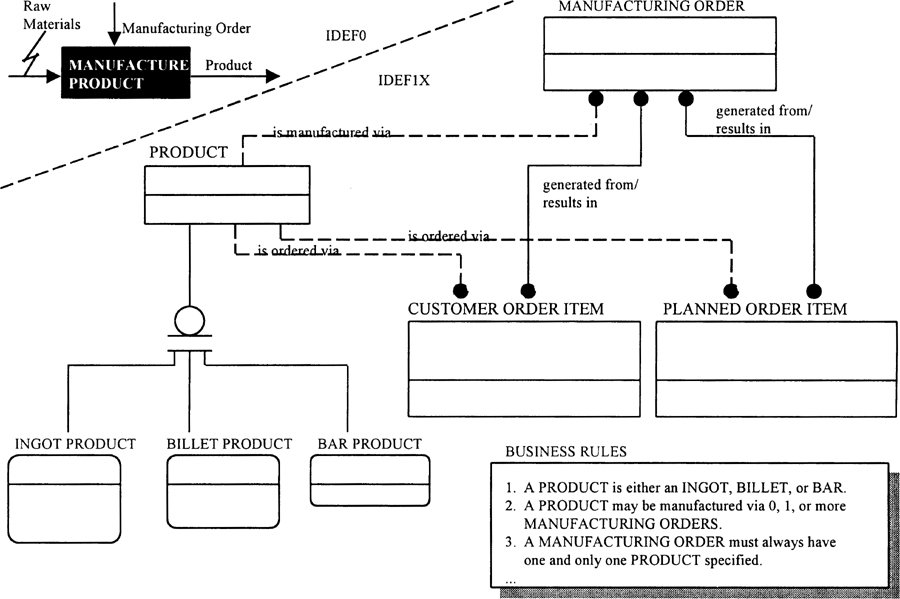Appendix D. SADT Data Models, IDEFO, and IDEF1X
SADT data modeling is closely related to activity modeling. With a data model, the entire system is modeled top-down, but this time the data elements are represented by boxes that are decomposed into subcategories of the parent data group. The activities become the arrows that show how the data is created and used. The control arrows become the activities that control how the data is called for or used. The mechanism becomes the device that holds the data (database and storage device).
Data decomposition of an SADT data model shows the enterprise’s data from a top-down perspective and identifies which activities directly use and create each data element. In this way, an SADT data model represents a dynamic view of the creation and use of enterprise data. This type of analysis graphically depicts the activities that are affected by a change in a data element—a key aspect of controlling change.
An IDEF1X model captures the relationships between individual data elements, the attributes of each element, and the means of identifying each element. If a data element has a discrete set of instantiations, these may also be displayed (such as the types of products produced by the enterprise).
Thus, the SADT data model and the IDEF1X data model complement each other; one shows the dynamics of data creation and usage, and the other shows the attributes and relationships of the data.
SADT data models are organized in a hierarchical, top-down decomposition structure similar to an SADT or IDEFO activity breakdown. However, there is no concept of hierarchy in IDEF1X—the model is a large chart with possibly hundreds of individual data items depicted. SADT data models employ the “gradual exposition of detail” feature to aid communication, whereas IDEF1X data models define in precise detail, so that data may be processed by a computer.
Experts disagree over which form of analysis should be done first. Because of the communication power of IDEFO, users typically opt for activity analysis first. That is, it is easier for users to consider groups of activities and organization structures than to see the forest for the trees in a large IDEF1X data model.
The decision partly depends on the type of system to be analyzed. For example, a banking system typically deals with very simple transactions (adding money to accounts, transferring funds, and so on), and the most important area to analyze is the massive data-handling effort involved in these applications. On the other hand, a complex manufacturing process is concerned with processes, rather than the short-lived intermediate data passed between workstations.
Another key aspect relating to sequencing is the ability to provide needed results in the most efficient way, in the shortest possible time, and at the least cost. Those who prefer to start with data analysis argue that integration can only be accomplished if the enterprise has a well-structured data infrastructure and that an analyst cannot begin to make meaningful progress until the enterprise’s terminology is clarified.
These are telling points, but activity analysts argue that you must have the processes understood and optimized before it makes sense to optimize the data. It does no good to optimize data that is not useful. Also, many forms of improvement (the introduction of Total Quality Management, the elimination of non-value-added tasks, or the introduction of new technology, for example) are only accomplished through careful analysis of the enterprise’s processes.
When starting the analysis of an enterprise, the first thing a modeler needs to accomplish is to define the terminology commonly used by the enterprise. Both IDEFO and IDEF1X recognize this fact: The starting point of an IDEFO model is to list and define the data elements at the top of the structure; the starting point of an IDEF1X analysis is to document the business rules either in a form of structured English or in IDEF1X entity-attribute-relationship form.
It clearly is overkill at the outset to define a complete, fully attributed data model, so the common procedure is to capture key entities and relationships, without worrying about solving many-to-many relationships, defining keys, or listing attributes at this early stage. The equivalent starting point for the activity analysis is to build a data dictionary so that meaningful interviews can be held to define the top-level diagrams of the model.
Since the same enterprise is being modeled in both cases, it is not surprising that the resultant models are related. Figure D-1 illustrates an IDEFO activity box and arrow set and its relation to an IDEF1X model of the same area.
An IDEFO activity box (MANUFACTURE PRODUCT) is shown in the upper-left corner of the figure. Upon inspection, the output arrow Product appears to be related to the IDEF1X PRODUCT box, which shows the three types of products and their attributes. Likewise, the IDEFO control arrow identifies Manufacturing Order as the control of the process, whereas the IDEF1X model breaks out the major elements of a MANUFACTURING ORDER.
The two models complement each other and provide needed detail for the analysis. In the IDEFO case, the information is gained by interviewing experts and creating a data dictionary for the terms “product” and “manufacturing order.” In IDEF1X, the business rules are captured in a form of structured English (see bottom-right corner of the figure) and then modeled as IDEF1X graphics by the data analyst (center of the figure).
In conclusion, the consensus is that some amount of process modeling should be done first before data modeling. Once the operational details of the enterprise are well understood, the time will come when an in-depth analysis using IDEF1X is essential. The statement is often made that “the key to an integrated, agile enterprise is integration of the information of the enterprise.” This is correct. However, the corollary should be stated: “Once the enterprise’s processes are optimized, there must be an integrated information infrastructure to achieve the benefits and provide the information needed to operate and control the enterprise.”

